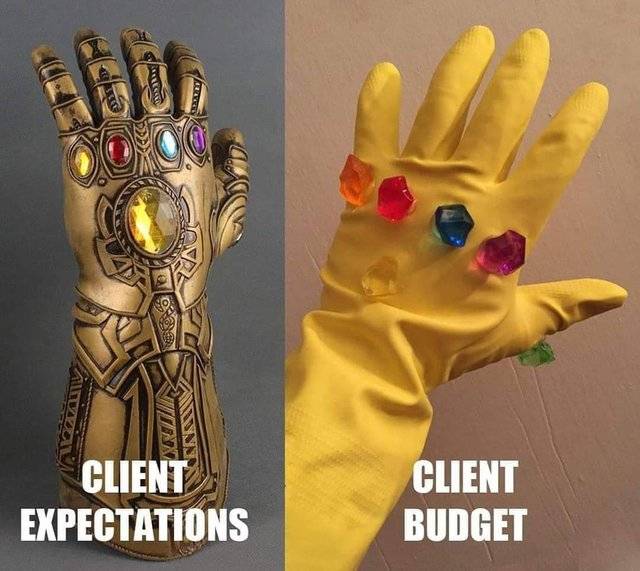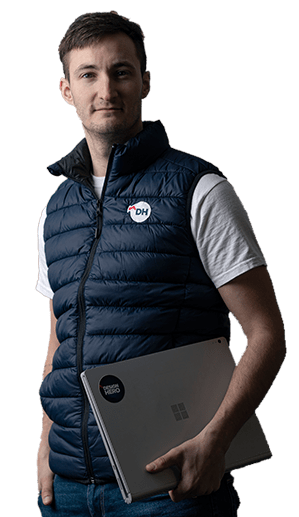This morning I had a call that made me want to black out my webcam.
A prospect reached out about a website project.
He’d designed it himself using AI and just wanted me to implement his masterpiece.
Within seconds of seeing his design, I knew it was a bag of shit.
They weren’t a paying client yet,
but still, I see it as my job to call a spade a spade and advise them honestly.
The colours clashed, the spacing was inconsistent, and the typography would your eyes bleed.
I gently suggested some improvements but he quickly told me how wrong I was.
“I know what I’m doing. I asked ChatGPT. I instructed it to use negative space.”
I started explaining that negative space was not relevant to legibility in this context,
But he quickly overrode me to tell me I was wrong
and also!
I was to recreate his design pixel perfect without modifications,
and also!
It needs done yesterday, since he had a big launch coming up and he’d left things a bit late,
but it should only take a “good” developer a few hours to build it, since he’d designed it already.
and also!
He’d paid a previous web developer to do it, but they’d let him down, so I was to charge him less since he’d already paid for it once already.
So many red flags…
I get a few calls like this each quarter. It’s no biggie.
At this point, it was obvious to me it wasn’t going to be a good fit.
So as soon as I could get a word in, I politely gave him a few pointers, wished him luck, and excused myself from the call.
I have a surplus of leads, so I’m fortunate to have the luxury of being selective about the projects I take on.
I had no wish to get involved with this project.
I’ve written about spotting client red flags, before
And this is not a rant about one difficult prospect.
It’s about a disturbing design trend I’m seeing more and more frequently in the design world,
which I believe will be supercharged by the rise of AI.
(yes another article about AI, sorry sorry🤦♂️)
For the most part, I’ve avoided doomspouting about if AI will steal design jobs,
But hopefully this will help you safeguard yourself against a new breed of “super red flag client”
🚩 The self declared expert
The self declared expert is the client who treats designers a as implementers, rather than strategists or partners.
– just another tool to be directed, manipulated, and instructed to produce exactly what they’ve already decided they want.
This isn’t new.
Every profession deals with this to some extent:
- Every mechanics has a customers who insists “a guy at the pub said this was the problem”
- Every designer has met a client whose aunt’s friend’s dog made some “improvements” to your design in PowerPoint
- Every Dr or nurse encounter patients who overrides a diagnoses based on 15 years of training after 5 minutes of Googling
This phenomenon is known as the Dunning-Kruger effect
Here’s what I know about it. (I spent 5 mins googling it 😅 )
The Dunning-Kruger Effect on Steroids
“A cognitive bias where people with limited knowledge in a domain vastly overestimate their abilities.”
This bias leads people to overestimate their abilities and underestimate the knowledge of others, particularly those with more experience or expertise.

Don’t underestimate the impact of the “self-declared expert”,
in fact it’s one of my strongest client red flags.
This kind of client can turn a straightforward design project into a battle of attrition,
Here’s what happens to your projects when trust in your expertise is lost:
- Client learns a few design terms from ChatGPT
- Client feels like they now “know design”
- Client stops considering how little they actually know
- Client needs to prove their knowledge by overriding your expertise
- They no longer trust your expertise, your design decisions are no longer accepted as given
- They start fact checking and getting 2nd opinions on everything
- Every piece of work becomes a battlefield to be picked over, discussed, and justified, you become defensive.
- Trust erodes. You spend hours discussing “options” for work that you’ve spent hours exploring already
- there goes your profit margin.
And here’s the irony – these clients expect a discount because they’ve “done half the work already.”
In reality,
My job is to provide a design that helps the client attract and sell to their ideal customers.
It takes me longer to explain and teach someone how to do each aspect of my job, than it takes to do my job myself.
AI devalues design at the low-end of the market
AI-powered tools are supercharging this problem to an entirely new level…
- Anyone can create a decent-looking graphic on Canva for free.
- Anyone can generate 3,000 legible, well-structured words using ChatGPT.
- Anyone can ask AI to “design a website” and get something that looks vaguely professional.
Before you just had this to deal with mismatched expectations of budget:

From now on, you’ll also have to deal with context not even matching anymore:

If you choose to live in the low end of the market, you are going to get the kind of clients that make demands, instead of asking questions and listening to advice.
Done With You costs more than Done for You.
Collaboration costs more.
This meme is a joke, but there’s truth in it:

AI is generative and predictive.
It’s based on whatever content came before.
It lacks wider context and the ability to know what’s correct for YOUR specific situation.
The output may even look visually appealing.
but a website without context is like a Ferrari without fuel:
it looks good but it’s taking you nowhere.
AI can produce an image which meets all the design rules:
a balance composition, a neat grid, a harmonising colour scheme, based on other websites in the same niche.
But it can’t tell WHY or WHEN it should produce these things,
and it doesn’t know when to break the rules when you need to stand out from others in your niche.
So what’s missing here?
Discernment.
“Discernment” is the new value you offer your clients
Discernment is the difference between knowledge and wisdom.
Anyone with an arm can pick up a hammer and beat a lump of iron
But it takes a blacksmith to hone it into a sword.
We can think of this kind of expert-level skill as ‘tacit knowledge:
stuff that is known but can’t necessarily be explained.
- It’s why a doctor gets a “feeling” about a diagnosis before any tests are done.
- It’s why it takes a writer to recognize good writing.
- It’s why I instantly knew this prospect’s design was terrible, though it took me 10 minutes to patiently explain why.
It’s a combination of structure, balance, contrast, brand context, typography, legibility, composition, knowledge of target market, experience translating flat design to web, and dozens of other factors built up over years of learning.
This “tacit knowledge” is something ChatGPT has yet to achieve.
Just as ChatGPT’s output by itself is only valuable when applied to a larger context,
Knowledge by itself is not valuable.
You probably know how to ride a bike or drive a car…
You could give me the knowledge of how to drive, break it down into steps to take.
But until I actually get in a car and start learning to drive,
I’ll never be able to drive a car.
I have to pick up the muscle memory, learn to spot hazards, to “discern” what to do and what not to do, and how much to do them.
So there’s only one way to protect against being undercut by cheaper AI designers:
Discernment protects your value as a designer
I’m certain AI will wipe out the lower end of the market for designers.
But here’s the thing – you don’t want to live at the low end of the market anyway.
If you’re pricing your design services at the bottom of the barrel, you’re going to attract clients like the one at the start of this article.
AI can reproduce low-quality work at a higher pace, lower cost, and often higher quality too.
But AI isn’t able to spot and produce quality, contextual work with the intrinsic knowledge of an expert (at least not yet).
So how do you protect yourself?
- Position yourself as a strategic partner, not an implementer
- Charge more – seriously, raise your prices
- Focus on the value your experience brings, not just the deliverables
- Develop and showcase your strategic thinking skills
- Build high-leverage skills across multiple areas
- Work with clients who value expertise over cost
The clients who are most susceptible to thinking AI makes them design experts are usually the ones you don’t want anyway. They’re price-sensitive, directive rather than collaborative, and generally more trouble than they’re worth.
By positioning yourself higher in the market, you’ll naturally filter out these clients and attract those who understand the value of true expertise.
Why AI is making your design clients more difficult to work with
The low-end of the market, attracts the kind of price-driven client who directs instead of listens.
At the low-end of the market, where design already lacks perceived value,
AI will turn designers from the go-to expert into a human puppet, actioning client’s ideas.
To avoid this designers must position as the expert and provide value as a strategist
So learn to spot work that delivers value.
Make sure your work speaks for itself,
And that you are building high leverage skills
Across a range of areas to protect your status as the go-to expert.

Struggling to position yourself as the expert and charge your worth?
Subscribe for instant access to my guided offer workshop for freelancers and solopreneurs.


























